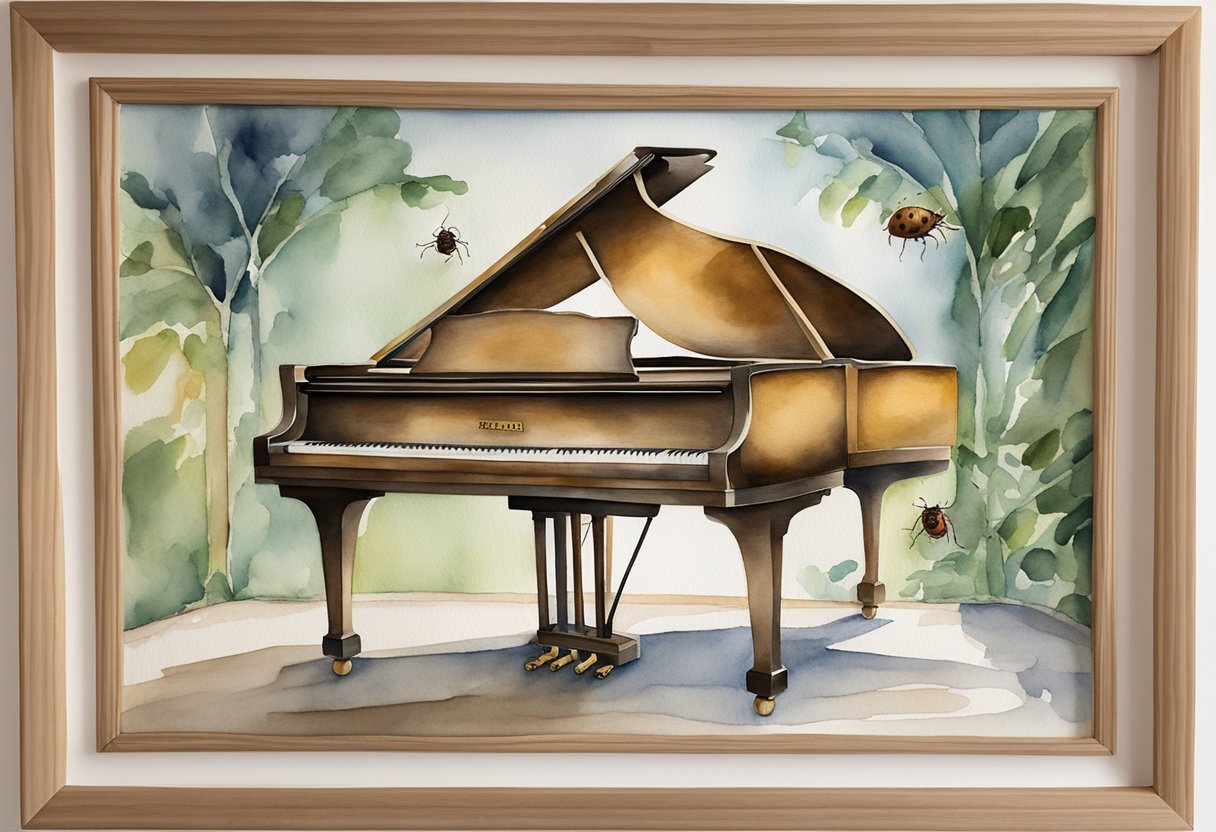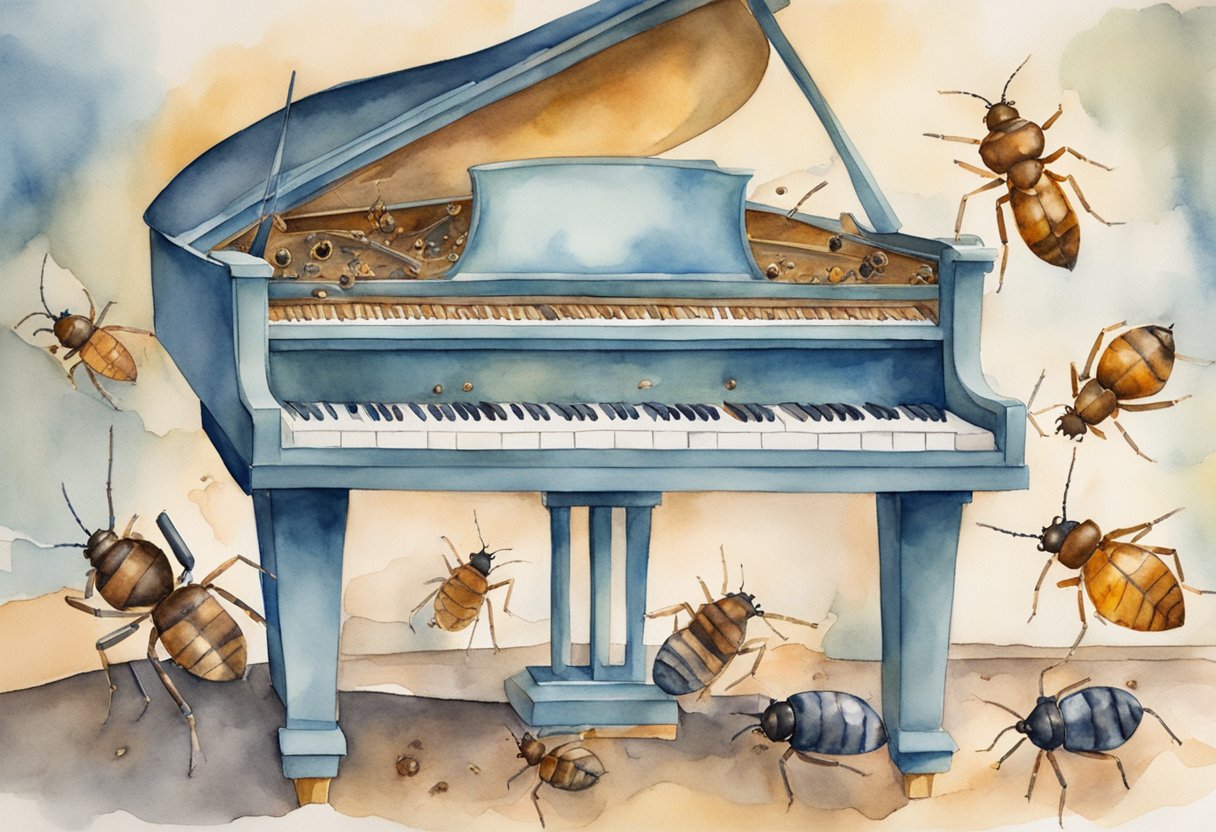As an Amazon Associate I earn from qualifying purchases.
As a professional pianist and music teacher, I’ve encountered numerous questions from students and fellow musicians, but one that often catches people by surprise is: can pianos have bed bugs? Indeed, it’s a possibility that many of us may overlook.
These pests are not just confined to bedrooms—they’re opportunists that can settle anywhere, including the padded, wooden, and felt components of your beloved instrument.
Want to Learn Piano?Click Here

If you’ve purchased a used piano or live in an area prone to infestations, it’s important to know that bed bugs can indeed find a home inside your piano.
These critters crave dark, hidden spaces, and a piano offers plenty of nooks and crannies. It’s not just an urban legend—ask any professional who’s had the unfortunate experience of dealing with a piano in an infested home, and they’ll confirm that these pests can become a real issue.
Given their stealthy nature, identifying an infestation early can save you a lot of trouble. Key indicators of bed bugs in your piano may include small dark droppings in the keys or along the soundboard, an unexplained musty odor, or even the sighting of the bugs themselves, which are small, flat, and reddish-brown.
Understanding Bed Bug Infestations in Pianos

Bed bugs are not just limited to mattresses and furniture; they can also find refuge in pianos, causing concerns for owners and players. It is crucial to know how to identify signs, understand their behavior, and recognize how pianos can inadvertently become a haven for these pests.
Identifying Signs of Bed Bugs
When it comes to pinpointing a bed bug infestation in your piano, vigilance is key. You’re likely to find bed bugs hiding in crevices or dark spots that are out of sight. Here are some signs to watch for:
- Dark spots: You may notice small, dark spots on the piano keys or within the internal structure, which could be bed bug excrement.
- Exoskeletons: Bed bugs shed their skins as they grow, so look for these tiny, reddish-brown shells inside the piano.
- Live insects: Although bed bugs are adept at hiding, a closer inspection might reveal adults or nymphs marching within the intricate parts of your piano.
Their flat bodies make it easy to slip into tight spaces in furniture, and yes, in pianos too. Furthermore, bed bugs are hardy creatures; adults can survive for months without a meal, making them a persistent issue once established.
How Pianos Can Harbor Bed Bugs
Your piano, with its wooden frame and felt hammers, among other parts, has several nooks that are perfect for bed bugs to take refuge. They can enter through tiny openings and hide in places such as:
- Under the keys: The area beneath the piano keys can host bed bugs, which remain unseen due to the dark and enclosed space.
- Within the action: The interior mechanical parts of a piano can offer shelter to these pests, who might be introduced to the instrument from another infested area.
- Along seams and joints: Anywhere the piano has small gaps or joins could potentially hide bed bugs.
Regular maintenance and cleaning of your piano can help prevent infestations. If you suspect bed bugs, it’s imperative to act quickly to mitigate the issue and protect your treasured instrument. Remember, the health of your piano is integral to the music it produces, so keep a watchful eye for these unwanted guests.
Managing and Preventing Piano Bed Bug Problems
When you think of bed bugs, sleeping areas typically come to mind, but your beloved piano can also be a target for these pests. Understanding how to inspect, clean, and prevent infestations is critical for the longevity of your instrument and the comfort of your playing environment.
Inspection and Cleaning Techniques
To ensure your piano stays free of bed bugs, routinely inspect hidden areas such as under the lid and beneath the keys. You should also regularly inspect other items in your music room, like bedding, luggage, and clothing, for signs of bed bugs, such as rust-colored spots or shed skins. If you notice any signs, a thorough cleaning is necessary:
- Vacuum every nook of the piano, including behind the baseboards, using an attachment to reach tight spaces.
- Wipe down surfaces with a mild cleaning solution.
- For items like piano covers, use a dryer on a high-heat setting, as the heat can kill bed bugs.
Professional Pest Control Solutions
In case of a serious infestation, or if you suspect the presence of pests such as termites, professional pest control is the safest route. Professionals can treat your piano and home with specialized methods, such as structural fumigation, that won’t damage your instrument.
They understand the delicate nature of pianos and will work to ensure your musical companion is not harmed during the extermination process.
Prevention Strategies and Tips
To prevent bed bugs from ever becoming a problem, consider the following strategies:
- Keep your music room clutter-free to reduce hiding spots.
- Cover your piano with a tightly woven cover when not in use, as this can help deter pests.
- Prior to bringing any used music equipment into your home, thoroughly examine it for signs of bed bugs.
- After travel, always inspect your luggage and clothing before entering your music room.
Regular maintenance and attention can make a world of difference in keeping your piano bed bug-free. By being vigilant with inspection, cleaning, and engaging professional help when necessary, you can focus more on your music and less on the inconvenience and potential negative health effects of pest infestations.
Hello & thanks for stopping by! I’m a professional concert pianist and piano instructor. In the United States, I’ve given successful performances in several places including New York, Florida, Connecticut, & New Jersey, I have also performed internationally in Italy and made my Carnegie Hall debut in 2014. I enjoy blogging about the piano, the art of performance, general music, current events and the latest in music production.
